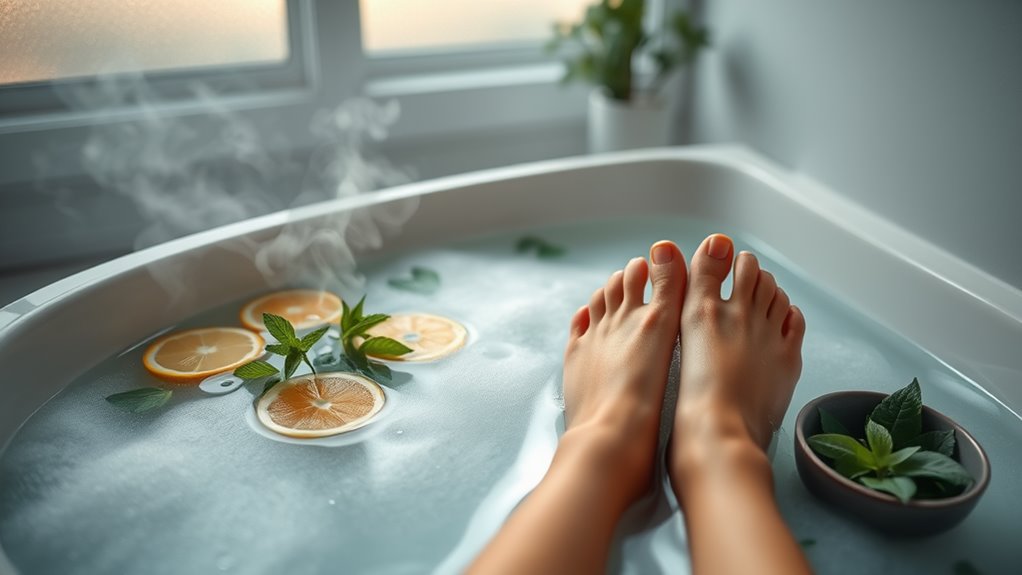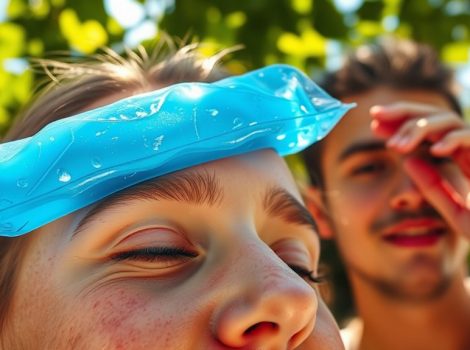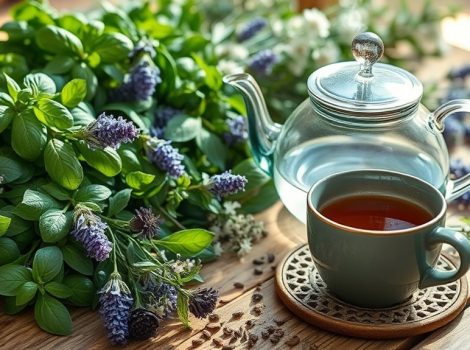Feel Cool Fast- Try This Fever-Fighting Foot Soak
When you’re dealing with a fever, finding ways to cool down quickly is essential. A simple foot soak can offer relief and help lower your body temperature. This method not only boosts circulation but also eases muscle tension. If you’re curious about the right ingredients and steps to create an effective foot soak, you’ll want to keep exploring. The benefits might just surprise you.
Key Takeaways
- Prepare a foot soak with warm water around 100°F, Epsom salt, and optional fresh herbs for added therapeutic benefits.
- Soak your feet for 15-20 minutes to promote relaxation and improve blood circulation.
- Consider adding ginger tea for its anti-inflammatory properties and honey for natural sweetness and immune support.
- Apply a cool compress on your forehead or take a lukewarm bath to further alleviate fever symptoms.
- Monitor fever closely; seek medical attention if it exceeds 103°F or persists beyond three days.
Understanding Fever and Its Effects
Fever is your body’s natural response to infection or illness, acting as a defense mechanism to help fight off pathogens.
When your temperature rises, it signals your immune system to spring into action.
This increased heat can enhance the effectiveness of white blood cells, making it harder for viruses and bacteria to survive.
While a mild fever can be beneficial, it can also lead to discomfort.
That’s where a foot soak for fever comes in.
Soaking your feet in warm water can provide relief, helping to lower your overall body temperature and soothe your aching body during this challenging time. Additionally, it’s important to remember that home remedies for fever should be used alongside proper hydration and rest to ensure a comprehensive approach to recovery.
Benefits of Foot Soaking
Soaking your feet in warm water offers a range of benefits that can enhance your overall well-being, especially when you’re feeling under the weather.
This simple practice promotes relaxation, reducing stress and anxiety, which can be crucial for your recovery.
It also improves blood circulation, helping your body fight off illness more effectively.
The warmth soothes sore muscles and may alleviate headaches, providing immediate relief.
Additionally, foot soaks can enhance sleep quality, making it easier for you to rest and heal. Furthermore, incorporating foot soaks as part of your routine can serve as a complementary approach to natural fever remedies, aiding in your recovery process.
Ingredients for the Perfect Foot Soak
Creating the perfect foot soak involves selecting the right ingredients to enhance your experience and maximize benefits. Here’s a simple guide to help you choose:
| Ingredient | Benefit | Emotion Evoked |
|---|---|---|
| Epsom salt | Reduces inflammation | Relief |
| Essential oils | Calming aroma | Serenity |
| Baking soda | Detoxifies skin | Refreshment |
Additionally, consider incorporating techniques that cool specific pulse points on your body to achieve a rapid temperature reduction.
Step-by-Step Guide to Preparing the Foot Soak
To prepare your fever-fighting foot soak, start by gathering all the necessary ingredients. Once you have everything, mix them to create your soaking solution. Finally, immerse your feet and take a moment to relax and let the soothing effects work their magic. Incorporating evidence-based home remedies can enhance your overall comfort during this time.
Gather Necessary Ingredients
Gathering the necessary ingredients for your fever-fighting foot soak is essential for maximizing its effectiveness.
You’ll need warm water, ideally around 100°F, to help soothe your feet.
Adding Epsom salt can enhance relaxation and draw out toxins, while essential oils like lavender or peppermint offer soothing scents and cooling properties.
Don’t forget a basin large enough to accommodate your feet comfortably.
If you have any fresh herbs like chamomile or rosemary, they can boost the soak’s therapeutic benefits.
Make sure you have a towel handy for drying off afterward.
With everything ready, you’re set to create your soothing solution!
Prepare Soaking Solution
Start by filling your basin with warm water, ensuring it reaches around 100°F for optimal comfort. Next, add your chosen ingredients, stirring gently to combine. Here’s a quick guide to common components and their benefits:
| Ingredient | Benefit |
|---|---|
| Epsom Salt | Reduces swelling and relaxes muscles |
| Essential Oil | Promotes relaxation and soothes |
| Baking Soda | Balances pH and softens skin |
| Vinegar | Antimicrobial properties |
Mix until dissolved, then test the temperature before soaking your feet. This soothing solution will help you feel better in no time!
Soak and Relax
Slip your feet into the warm, soothing soak and let the tension melt away. As you immerse your feet, breathe deeply and focus on the calming sensation.
This foot soak not only relaxes muscles but can also help reduce fever by promoting circulation. Keep your feet submerged for 15-20 minutes, allowing the warmth to draw out discomfort.
You might want to add a few drops of essential oils like eucalyptus for added relaxation.
After soaking, gently pat your feet dry and elevate them for extra comfort.
This simple ritual can rejuvenate your body and mind, helping you feel cooler and more relaxed.
Tips for Maximizing the Effects of the Soak
To get the most out of your foot soak, pay close attention to the water temperature and soaking duration.
Ideally, you want the water to be warm but not too hot, as this helps promote better circulation without causing discomfort.
Aim for a soaking time of about 15 to 20 minutes to maximize the therapeutic benefits. Incorporating techniques like lymphatic drainage massage can enhance the overall effects of your soak by improving circulation and reducing swelling.
Optimal Water Temperature
Finding the right water temperature is crucial for maximizing the effects of your fever-fighting foot soak. Aim for warm water, around 98 to 104 degrees Fahrenheit.
This temperature promotes blood circulation, helping your body release heat more effectively. Avoid water that’s too hot, as it can cause discomfort or even worsen your fever.
To gauge the ideal warmth, test the water with your wrist; it should feel comfortably warm, not scalding. Remember, the goal is relaxation and relief, so listen to your body.
Duration of Soaking
Soaking your feet for 15 to 30 minutes can greatly enhance the benefits of your fever-fighting foot soak.
This duration allows your body to absorb the cooling effects effectively, helping to lower your overall temperature.
During this time, the warm water encourages blood flow, promoting relaxation and aiding in detoxification.
To maximize results, try incorporating gentle foot massages while soaking; this can further stimulate circulation.
If you start to feel uncomfortable or overheated, don’t hesitate to adjust the water temperature or take breaks.
Consistent soaking, ideally twice a day, can provide ongoing relief and support your recovery.
When to Seek Medical Attention
When should you consider seeking medical attention for a fever?
If your fever reaches 103°F (39.4°C) or higher, it’s time to call a healthcare professional.
Also, seek help if your fever lasts more than three days or if you experience severe symptoms like difficulty breathing, persistent vomiting, or rash.
For infants under three months with a fever, immediate medical advice is crucial.
Don’t ignore fever accompanied by confusion, severe headache, or stiff neck, as these could indicate serious conditions. Additionally, a homemade flu remedy can help alleviate some symptoms, but it should not replace professional medical care.
Being proactive about your health ensures you receive the necessary care to recover quickly and safely.
Other Home Remedies for Fever Relief
There are several effective home remedies you can try to alleviate fever symptoms and promote comfort during your recovery.
Stay hydrated by drinking plenty of fluids like water, herbal teas, or broths, which help regulate body temperature.
You might also find relief with a cool compress on your forehead or taking a lukewarm bath.
Ginger tea has anti-inflammatory properties that can soothe discomfort, while honey’s natural sweetness can make it more enjoyable. Additionally, incorporating raw honey and ginger into your regimen may provide a potent boost to your immune response.
Lastly, ensure you’re resting adequately; your body needs energy to fight off infection.
Combining these remedies can enhance your overall comfort and support your healing process.




